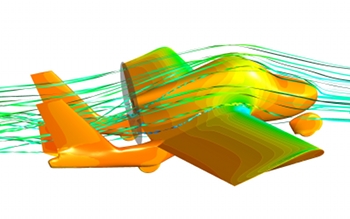
Terrafugia’s “Flying Car” to launch next year
By DE staff
General ANSYS TerrafugiaHistoric vehicle optimized for flight and driving with minimal physical testing with help from ANSYS.

Since the rise of popular science fiction literature, visions of the future have commonly included flying cars. If you’re tired of waiting, you’re in luck. Next year, Massachusetts-based start-up Terrafugia is scheduled to roll out the Transition (video link), the world’s first commercial flying car. Unveiled yesterday at the EAA AirVenture airshow, the vehicle is not only street legal, the company says, but also capable of short range flights.
Combining a lightweight, aerodynamic aircraft with long-distance highway driving, the Transition can cruise up to 490 miles at more than 105 miles per hour, can drive at highway speeds on the road and is capable of transforming from plane to car in less than 30 seconds. The sophisticated design features foldable wings that span more than 26 feet, a rear-wheel-drive system for the road and a propeller for flight. Once transformed, the Transition has a flight range of around 787 km (490 mi). Terrafugia’s team of aeronautical engineers earned global attention when the Transition proof-of-concept vehicle completed a successful 60-second test flight in March 2009. The company expects to begin commercial production of the vehicle in 2011.
To design the Transition, the company used ANSYS engineering simulation software to verify its production prototype aircraft. Terrafugia engineers conducted whole-vehicle airflow tests that assessed the effects of design changes on overall performance — working in parallel across the various Transition components. The simulations were used to maximize wing lift in the air and to minimize the effects of crosswinds along the road.

Image courtesy Terrafugia.
